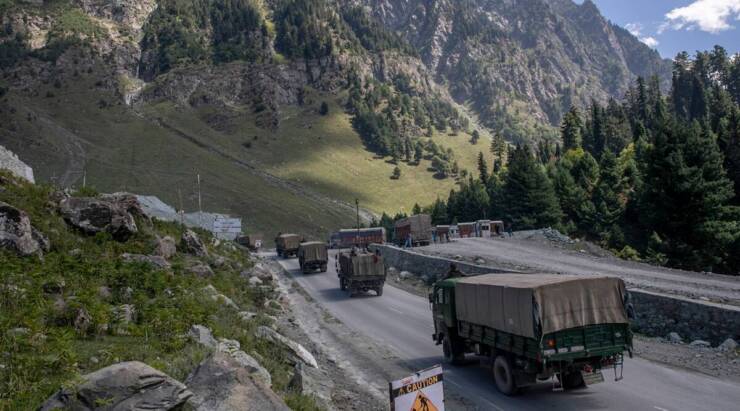
Global Security Canvas and Future Threats
The geopolitical fragility weakened by the pandemic and the fundamental transformation in the global landscape has cast security challenges around the Asian landmass and the oceanic tides of the Indo-Pacific. Both the economic centre of gravity and the potential conflict zones are surely shifting towards Asia, leading to rising military competition and defence expenditures. China’s disruptive rise has altered the balance of power with its unilateralism, aggression and revanchism, fuelling rivalries and contestations. Pakistan’s military, economic, ideological, geostrategic tandem with China will play a collusive threat to destabilise India.
India’s balancing posture, economic potential and demonstrated military are thus seen as a stabilising factor against global turbulence and competitive geopolitics. Indian strategic security vision accordingly must envision the future global security canvas while addressing the existent military threats to the nation. The two-front dynamics along with internal front turbulence is a reality today that we need to squarely face. The Ladakh impasse has once again highlighted the sensitivity of the physical and psychological congruence of two fronts. Both on the Western Front and the Northern Front our current deterrence strategies have failed to hold good. This translates into the imperative of honing our conventional deterrence against the revisionist strategic culture of our adversaries, ranging from brewing proxy war to incremental territorial expansion.
2020 The Year of Military Awakening
The Year 2020 has thrown up some of the biggest strategic security challenges for the nation and its defence forces since Independence. Strategically we focused on the wrong front knowing full well that the primary threat lay elsewhere. Doklam had sounded the threat at the doorsteps leading to Ladakh. This led to strategic surprise and disorientation both of military capability building and strategic-cum-operational military leadership focus. Ironically, the era and aura of ‘number game‘ and ‘surgical strikes’ on the less threatened front, seemed to have been a more attractive mantra for stirring hyper-nationalism, military recognition, career progression, only to boomerang when Ladakh 2020 manifested in a macro replay of Kargil 1999. We focused on counterinsurgency effort, ideally the domain of para-military forces (PMF), and traditional orthodox ground-holding ethos on the balance front, in a typical attritional tactical mindset, missing out the larger domain of domination and dislocation as the key determinant of deterrence in tune with manoeuvre warfare.
National Security and Deterrence
National security is an amalgam of political stability and democratic maturity, human resource optimisation, decisive national leadership, economic resilience, technological competence, indigenous industrial base, availability of natural resources and finally a dynamic defence capability leading up to a strong state-of-the-art military deterrence. Information warfare and strategic communications remain important tools for conveying this intent.
Deterrence in the Indian strategic security construct is thus currently aimed at punitive deterrence on the western front and dissuasive to credible deterrence on the northern front. Punitive deterrence is based on the premise of assured retribution and making the cost prohibitive than the benefit of proxy war or territorial aggression. Dissuasive deterrence or deterrence by denial aims to deter aggression by convincing an adversary that the aggression would fail to achieve its operational and strategic aims. Thus the status quo will be construed as a victory by the defender. Credible deterrence in its more dynamic form includes the limited offensive capability for a quid pro quo gain and the dilution of the aggressor’s offensive capacity by forcing him to divert resources to his defence, thereby generating the ability to take the war to the enemy and increasing the political cost of aggression. This would aim at strategic embarrassment and defeat. However, while our deterrence has been repeatedly put to test in the recent past, it has also led to the exposure of strategic and operational voids, vulnerabilities and response mechanisms, in our deterrence capabilities. These need to be addressed expeditiously before the next round, which may well be around the corner. Deterrence as an adjunct to military strategy thus needs to keep pace with the realism of evolving geopolitics and emerging threats to national security.
Deterrence Construct
Wars are fought to ensure lasting peace and deterrence is an instrument towards the furtherance of that peace. However, the application of deterrence concepts and capabilities require formulation in the context of the adversary’s behaviour and strategic culture. Deterrence is much more than posing a threat to the aggressor and must shape his perception of the cost-benefit of war. Thus a fundamental difference exists between the concepts of deterrence and defence: deterrence seeks to make conflict look bad to the enemy, while defence seeks to make conflict better for oneself by stalling the aggressor. This is the essence and something the Indian security needs to understand and imbibe in their military strategy. Thus capability, credibility and communication are the keys to successful deterrence.
Deterrence has two fundamental approaches – Punitive Deterrence or Deterrence by Punishment and Credible Deterrence or Deterrence by Denial. Strategy by denial is inherently more reliable than punishment strategies. An aggressor might question a defender’s willingness to impose punitive and escalatory responses because of the attendant risk of escalation. Thus placing significant military capabilities to dominate the path of an aggressor have higher visibility and effect.
Indian Deterrence Paradox
India’s deterrence has been repeatedly put to test in the recent past, leading to the exposure of strategic and operational voids, vulnerabilities and reactive-response constructs. India’s professed punitive deterrence on the western front and credible deterrence on the northern front has failed to hold good essentially because of the reactive and defensive mindsets of the past. While we doctrinally profess tenets of Preemption, Dislocation and Disruption as part of our Proactive Operations strategy, we are essentially reactive, attritive, land-centric and tactical, leading to an orthodox defensive-reactive strategy deeply embedded since Independence.
Our recent strategic hesitancy to take the conflict across the threatened front and focus on land-centric responses as visible both at Kargil 1999 and Ladakh 2020 have shown our deterrence in poor light. Thus deterrence and domination have remained just clichés. In fact, it has motivated our rivals to pursue more provocative strategies of their own, including Pakistan’s tactical nuclear weapons and China’s incremental land grabs. Thus, both borders remain turbulent with possibilities of limited conflict high.
Strengthening Deterrence
The need is for a dispassionate review of our conventional deterrence with an accent on pre-emption and offensive proactive orientation. Deterrence by denial must take higher preference than Deterrence by Punishment, which is increasingly porous. This requires both induction of technology, a doctrinal shift in multi-domain warfighting, joint force application strategy and above all change of mindsets and leadership focus.

Deterrence against Pakistan requires more teeth particularly in long-range precision stand-off capability with periodic strikes on terrorist launch pads or training areas and punitive border ceasefire violation response, while being prepared for the next ladder of escalation. A status quo will be a victory for Pakistan. The tit for tat and number game of kill ratios in the valley must be replaced by more lethal, pre-emptive and punitive force application and addressing the psychological and ideological domain of the populace. It’s time Pakistan is made to react to India’s proactive overt and covert actions, borrowing the traditional deniability of Pakistan. An irate and obsessed Pakistan would not understand any other language.
On the other hand, deterrence against China is a more challenging form of denial deterrence. It entails an offensive-defence strategy along with a limited offensive preemptive capability. This would dilute China’s offensive capacity by forcing it to divert resources to its defence, taking the war to the enemy’s territory and increasing the political cost of aggression. A sample of what was done at Kailash range recently. This would cause strategic embarrassment and de-facto defeat to the aggressor. China’s response must also be physically and psychologically constrained by multilateral and bilateral security partnerships.
While the integrity of the continental periphery will remain primary, the importance of the maritime and aerospace domain merits due focus in our deterrence strategy. India must thus calibrate its military capability as a sum total of synergetic application of warfighting elements in all seven mediums – land, air, sea, space, underwater, cyber and the cognitive domain. India’s deterrence in the Himalayas will thus have to be empowered by its ascent as an aerospace and maritime power. In addition to technology induction, areas of C5ISR, Information Warfare, Cyber, Space, unmanned systems and AI must find the requisite focus in our capability development both in the kinetic and non-kinetic domain.
Credibility in deterrence also has a close bonding to commitment. Commitment is political with due fiscal allocation for capability development and often put to test especially against a powerful adversary. When a challenge is directed against the vital interests of the state, credibility is virtually assured. However, it is where commitment is questioned, that challenges are most likely to occur. A strong political will to commit forces and to convince a potential aggressor that the deterrer will carry out a threatened action irrespective of the cost will only be credible if the capacity and commitment exist.
Building of a Strong Military
A strong military cannot be built on paltry budgets ending in emergency panic procurements under crisis. It also needs indigenous manufacturing prowess and greater technological capabilities with a focus on joint force capability building and synergetic application. In this sphere, we need to walk more than talk. Further, defence transformation and restructuring is a critical facet of military capability building that must be progressed with due deliberation and foresight. It must be focused on outcomes for enhancing efficiency specific to our threats and desired capabilities, rather than additional bureaucratic layers or additions to higher ranks with old mindsets in pursuit of political diktats.
Ironically, with the absence of a National Security Strategy, India lacks the foundational construct for restructuring and capability building and thus remains more reactive to a crisis situation, which seems to be our forte. An operational directive without a National Security Strategy often results in a task-to-capability mismatch as has been in the recent past. Technologically we kept our modernisation focus to fight the last war, strategically we lacked a National Security Strategy and integrated culture, and operationally, our military leadership was found wanting in the nuances of the operational art of fighting limited wars having become counter-insurgency oriented. The tactical level of blood, guts and glory has always been the ultimate saviour for the nation, though at a much avoidable cost to precious lives.
Conclusion
The pendulum of war and peace on our turbulent disputed borders will continue to have its dynamics in terms of competing challenges of gaining ascendancy in the strategic space, time, forces and information domain. The probability of our nuclear-armed neighbours engaging in a decisive full-scale war is low. To achieve their political aims they are thus likely to exploit a combination of the plethora of multi-domain options as the salience of military coercion below the threshold of war. The recent threats manifestation on our Western and more significantly on our Northern borders are witness to the same.
The Indian military has failed to keep pace with these strategic changes and thus the present deterrence construct was found to be porous. India also lacks a strategic security framework and periodic review process. India’s cost-imposition strategies are thus skewed and unlikely to deter its rivals from continued sub-conventional provocations to territorial land grabs. Thus Indian Defence Forces must invest greater focus and energy on rebalancing its deterrence doctrine from punitive to denial strategies.
-The writer has had an illustrious career spanning nearly four decades. A distinguished Armoured Corps officer, he has served in various prestigious staff and command appointments including Commander Independent Armoured Brigade, ADG PP, GOC Armoured Division and GOC Strike 1. The officer retired as DG Mechanised Forces in December 2017 and was Consultant MoD/OFB from 2018 to 2020. The Officer is a reputed defence analyst, a motivational speaker and prolific writer on matters military, defence technology and national security. The views expressed are personal and do not necessarily reflect the views of Raksha Anirveda








